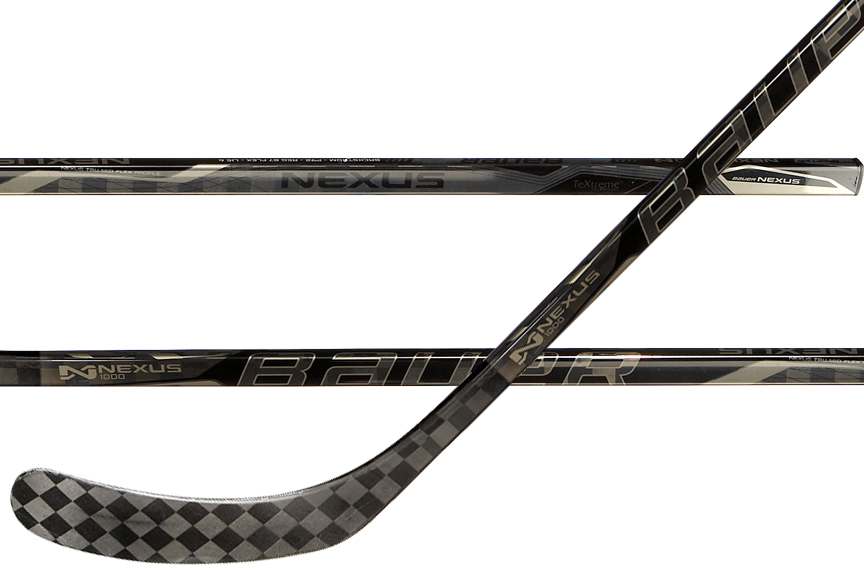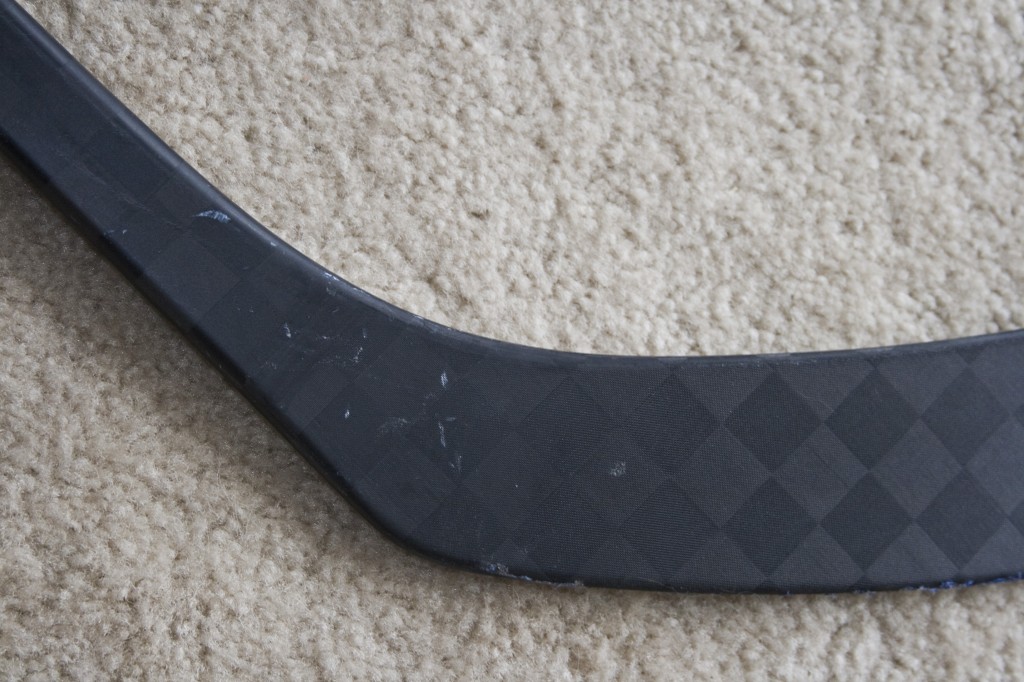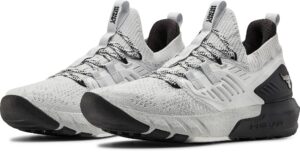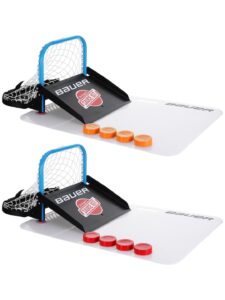As one of the leading hockey equipment manufacturers today, Bauer is definitely a name synonymous with hockey. They continually push the envelope to provide players with innovative, high-quality equipment that will take their game to the next level. Enter the Bauer Nexus line of equipment, the first completely new family of equipment from Bauer since 1997, which brought with it the brand new Bauer Nexus 1000 hockey stick – the premier stick in the Nexus family.
Specs: Bauer Nexus 1000, 87 Flex, P9 (Stamkos) curve, Lie 5
Modifications: Cut one-and-a-half inches off the butt end
Design and Construction: The Nexus hockey stick has a very sleek, minimalist design. Bucking the trend to go white, Bauer instead opted for an all black shaft with gun metal gray accenting throughout. The result is a stick that looks bland from far away, but offers more visual stimulation upon closer inspection.
The stick combines all of the top technologies from both the APX and TotalOne sticks and features square double concave walls, TeXtreme carbon fiber construction and monocomp technology that eliminates excess material from the construction process. This helps create a true mid-flex in the shaft that is intended to provide a quick, effortless and natural release.
The Nexus has a smooth matte finish grip and weighs in at 413 grams – right in between Bauer’s other top-end performers: The TotalOne NXG (406g) and the Vapor APX (417g). The stick has a nice, light feel and is well balanced throughout the shaft with no discernible top-heavy or blade-heavy feeling – even after cutting the stick down a little over an inch.
The only drawback is that the stock length of the Nexus seems to come in a bit shorter than the top-of-the-line offerings from other brands right now. The Nexus comes in at 60 inches, which puts it anywhere between half an inch to three inches shorter than the top-end products from other manufacturers. While this wasn’t an issue for me, it could present a problem for taller players who may need to add an extension, which could alter the weight distribution.
Feel: Feel for the puck is an important feature of hockey sticks and can help provide a higher level of confidence while you’re playing. I’ve had the opportunity to get a lot of usage out of this stick in a short amount of time, both on the ice and playing roller hockey. Feel for the puck with the Nexus 1000 is good, not great, but not bad either. To be honest, I’ve had a chance to use Bauer’s other top-end sticks a few times, and I think of the three, the Nexus has the worst feel for the puck. Granted, it’s still much better than some other sticks I’ve used before.
It’s tough to adequately describe, but puck handling almost feels “stiff.” When you’re skating with the puck, the Nexus doesn’t seem to be as sensitive throughout the shaft when the puck contacts the blade. It makes me wonder how much the “true mid-flex” profile of the stick impacts the puck handling performance. Comparing the specs of the Nexus to the TotalOne NXG, the blade structure is similar, as is the construction of the shaft, really leaving the flex profile to take into consideration. The shaft supposedly gets stiffer in the mid-section to help create the “natural” release of the mid-flex profile. This increased stiffness very well could account for the tame feel for the puck.
Again, that’s not to say the feel for the puck is bad by any stretch. I’ve performed very well with the stick in games and haven’t had any issues losing the puck from my blade and not realizing it when I’m handling the puck. You won’t suffer from a lack of feel when using this stick. Still, when compared to even Bauer’s other top-end performers, you realize that the feel could be even better.
Shooting and Accuracy: Even when the first one-piece sticks were introduced several years ago, I still held onto my shaft-and-blade combo for quite a long time before making the switch. I liked the performance I got from shafts and blades and wasn’t ready to spend the money on a one-piece. So when I initially heard about the mid-flex profile of the Nexus hockey stick, I wondered how similarly it would perform to using a shaft and blade. In my experience, it performs very similarly to that setup.
You can expect to do a little more work with this stick to make it perform. I find myself really having to lean into shots and load them up to get good velocity and power, just like I did with a shaft. Also, to get better power and accuracy, I find myself holding my bottom hand a few inches lower on the shaft, just like I did with a shaft.
Here’s the problem: I haven’t regularly used a shaft in four or five years. So, it took some time to readjust to the Nexus and figure out how to get the best performance.
I’m happy with the shot velocity and power I get from this stick. Again, expect to weigh into your shots a little more to generate that power, but when you load up properly you get solid results.
Accuracy is very good with the stick, too. Just the other day I was playing a pick-up game and one of our goalies didn’t show so we played posts on one side. I was sniping posts left and right with this stick. I’m not talking from two feet out – I was hitting them from the slot five to ten feet out. Even my misses were darn close. Even when goalies are in the net, if I don’t score it’s not because I didn’t put the puck where I wanted it. The goalie just happens to have a quick glove. Overall, I’m very pleased with the accuracy the Nexus 1000 provides.
For some reason, however, passing is a little different story. I find my passing going errant, and I constantly struggle to make tape-to-tape passes. That’s not the normal. I’m typically a very accurate passer. So, after struggling to make solid passes in warm-ups before a recent skate, I switched sticks to see if it’s me or the stick. The new stick performed great and definitely improved my passing accuracy, making me think the Nexus is the faulty performer.
 Is there a reason for my passing struggles? Maybe. The PM9 curve of the Nexus is definitely more open than some of the curves I’ve been using on other sticks recently, so at first I figured it was just because I needed to readjust. However, like I stated previously, I’ve used this stick a lot – particularly over the last few days – and my struggles haven’t really improved.
Is there a reason for my passing struggles? Maybe. The PM9 curve of the Nexus is definitely more open than some of the curves I’ve been using on other sticks recently, so at first I figured it was just because I needed to readjust. However, like I stated previously, I’ve used this stick a lot – particularly over the last few days – and my struggles haven’t really improved.
Durability: This is one area where I have no complaints thus far. After about 10 games over the last few weeks, the Nexus shows very little sign of wear. Sure, there are some small blemishes, but not nearly to the point that I would expect after that much usage. Most of the blemishes are within the slash zone (pictured) and a little onto the heel-end of the blade where you would expect to see them after heavy usage, but none of them are deep scars with chunks of material missing. They are literally just a couple surface scratches and marks. Outside of that, I haven’t noticed any loose chips rattling around on the inside and am happy with how the stick’s flex has held up so far. At this rate, I’m confident that the stick will hold up long term.
Overall Impressions: Several NHL players, like Ryan Kesler of the Vancouver Canucks, endorse this stick and rave about its performance. Much like their different lines of skates, Bauer’s different lines of sticks offer something for everyone and it’s all about finding the right fit for you. Personally, I think my style of play and equipment preferences would benefit more from one of Bauer’s other top-end sticks.
The Bauer Nexus 1000 hockey stick is a solid offering from Bauer with several good qualities. The stick offers a good feel for the puck, very good accuracy on shots, and thus far appears to be incredibly durable. It’s an all-around good performer that both forwards and defenseman will enjoy and those who liked the shaft-and-blade setup from years ago will definitely like how this stick performs.
Interested in purchasing the Bauer Nexus 1000 hockey stick? Head over to Pure Hockey where readers can get a 10% discount off their order by using the coupon code “HOCKEYWORLD”.



APX, rs2, or dt1? Thanks.
Easton sticks have had durability issues in the past (and I just generally don’t care for the way they play) so I’m hesitant to recommend the RS2. I think you’d be fine with either the DT1 or the APX. I haven’t had much of a chance to use the DT1, but I’ve shot around a little with the APX and I really like the way it plays. I don’t know how much of a hurry you’re in but I should have a review up with more detailed info on the APX soon.
I’m a equipment manager for a team
In the ccha. The nexus has been used by our team since about last December when certain players were going through apxs rather quickly. They were painted like a apx but anyone who used an apx before loved the nexus saying there stronger lighter and simply better made.
That’s very good information. As someone who attended a CCHA school, I know how frequently players go through sticks. What kind of sticks does your goalies use? Wood or composite?
Our goalies all hate composite goalie sticks they say they vibrate in there hands to much an the rebounds aren’t as easy to control as with the wood stick but bauer’s goalie break quickly the shafts split within a few practices. Even with the amount of sticks there goen through they still won’t use a composite.
Hi guys- love the site, thanks for being so responsive to questions too.
Quick question. I have gotten clearance from corporate (wife) to pull the trigger on a new twig. I’m a Bauer faithful- thinking about cost and endurance too though. I’m between a Nexus and an x70. I know the x70 can lose pop from experience, so is the Nexus worth the price point?
Thanks again,
Hi Seth-
Thanks for the question.
One important thing to remember is that the Nexus has a mid-flex profile, whereas most of Bauer’s other sticks (the TotalOne and APX line) have the lower flex point. Personally, I prefer the lower kick-point of the other sticks.
That being said, the Nexus will still set you back a pretty penny, and I found the overall performance of the APX line and the TotalOne line to be better than the Nexus. Again, personal preference, but those were my findings. As a Bauer faithful, you might want to look into the original Bauer APX stick. With the recent release of the APX 2, the original APX sticks are on sale, so you get the benefit of a great top-end stick for less cost.
If you decide to venture out to another brand, I also highly recommend the RBK 20K SickKick 4. They are going for about $200 right now. I used this stick extensively and found it to be very durable, lightweight and overall a quality stick.
If you’re willing to spend the money and want something a little newer, the CCM RBZ Stage 2 is a strong option. It provides a noticeable difference in shot velocity. We should have a full review of that one up on the site shortly.
Hope this helps answer your question!